Pulses Market
Pulses Market Size and Share Forecast Outlook 2025 to 2035
Pulses market is projected to grow from USD 36.0 billion in 2025 to USD 46.8 billion by 2035, at a CAGR of 2.7%. Dry peas/beans will dominate with a 38.0% market share, while whole pulses will lead the by form segment with a 64.0% share.
Pulses Market Forecast and Outlook 2025 to 2035
The global pulses market is expected to grow from USD 36.0 billion in 2025 to approximately USD 46.8 billion by 2035, recording an absolute increase of USD 10.8 billion over the forecast period. This translates into a total growth of 30.0%, with the market forecast to expand at a CAGR of 2.7% between 2025 and 2035.
The overall market size is expected to grow by nearly 1.3 times during the same period, supported by increasing global protein demand, growing adoption of plant-based nutrition solutions in food manufacturing, and rising sustainable agriculture awareness driving premium pulse procurement across various food processing applications.
Quick Stats for Pulses Market
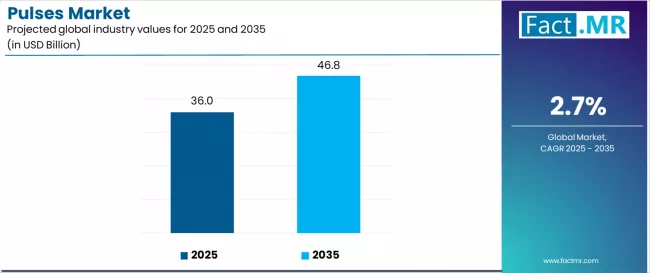
| Pulses Market Value (2025) | USD 36.0 billion |
|---|---|
| Pulses Market Forecast Value (2035) | USD 46.8 billion |
| Pulses Market CAGR | 2.7% |
| Leading Segment by Type (2025) | Dry peas/beans (38.0%) |
| Leading Segment by Form (2025) | Whole pulses (64.0%) |
| Leading Segment by End Use (2025) | Food (78.0%) |
| Key Growth Regions | North America, Europe, and Asia Pacific |
| Top Companies by Market Share | AGT Foods, GPC, Olam |
Pulses Market Key Takeaways
| Metric | Value |
|---|---|
| Market Value (2025) | USD 36.0 billion |
| Market Forecast Value (2035) | USD 46.8 billion |
| Forecast CAGR (2025-2035) | 2.7% |
Why is the Pulses Market Growing?
| NUTRITION & SUSTAINABILITY TRENDS | FOOD MANUFACTURING REQUIREMENTS | REGULATORY & QUALITY STANDARDS |
|---|---|---|
| Global Protein Demand Growth | Sophisticated Processing Requirements | Food Safety Standards |
| Continuous expansion of protein consciousness across established and emerging markets driving demand for plant-based protein solutions. | Modern food manufacturing requires versatile pulses delivering precise nutritional profiles and enhanced processing functionality. | Regulatory requirements establishing quality benchmarks favoring high-quality pulse ingredient systems. |
| Plant-Based Nutrition Recognition | Sustainability Demands | Nutritional Labeling Standards |
| Growing emphasis on plant-based proteins and sustainable nutrition creating demand for pulse-based ingredient technologies. | Food manufacturers investing in eco-friendly ingredients offering consistent performance while supporting environmental compliance requirements. | Quality standards requiring superior protein content and accurate nutritional declarations in pulse applications. |
| Premium Sustainability Positioning | Quality and Traceability Standards | Organic Certification Requirements |
| Superior environmental impact and carbon footprint characteristics making pulses essential for eco-friendly food applications. | Certified suppliers with proven eco-friendly farming practices required for advanced plant-based ingredient applications. | Diverse regulatory requirements and organic standards driving need for scientifically-validated eco-friendly pulse solutions. |
Pulses Market Segmentation
| Category | Segments Covered |
|---|---|
| By Type | Lentils, Chickpeas, Dry peas/beans |
| By Form | Whole pulses, Processed flour/Protein isolates |
| By End Use | Food, Feed/Others |
| By Region | North America, Europe, Asia Pacific, Latin America, Middle East & Africa |
Pulses Market Analysis by Type
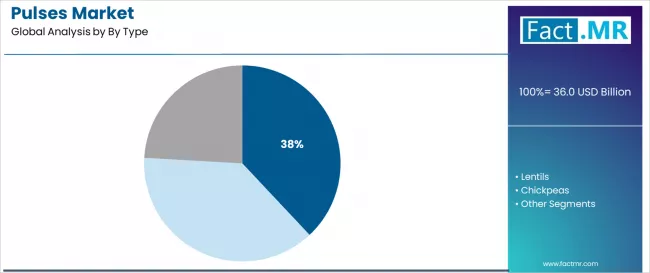
| Segment | 2025 to 2035 Outlook |
|---|---|
| Dry peas/beans | Leader in 2025 with 38.0% market share; likely to maintain leadership through 2035. Established global production systems, diverse variety options, and proven versatility across food and feed applications. Momentum: steady growth driven by plant-based protein demands and processing innovation. Watchouts: weather sensitivity, regional production concentration. |
| Lentils | Strong segment with 32.0% share due to superior protein content and cooking convenience characteristics. Benefits from health positioning and growing consumer awareness of nutritional benefits. Momentum: moderate growth through 2030, supported by health food expansion and protein diversification trends. Watchouts: supply volatility, regional cultivation limitations. |
| Chickpeas | Represents 30.0% market share, benefiting from Middle Eastern and Mediterranean cuisine popularity and hummus market expansion. Growing interest in versatile protein applications and snack food innovations. Momentum: rising rapidly via ethnic food trends and protein snack development. Innovation-dependent with processing technology advancement and application diversification. |
Pulses Market Analysis by Form
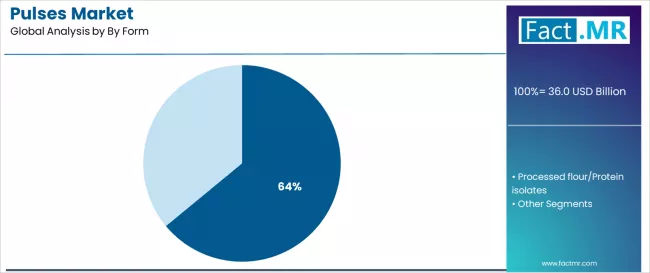
| Segment | 2025 to 2035 Outlook |
|---|---|
| Whole pulses | Dominant segment with 64.0% market share, encompassing traditional whole pulse consumption and direct food applications requiring minimal processing. Established consumer preferences with cultural significance in many regions. Momentum: steady growth driven by traditional food consumption and whole food trends. Watchouts: processing convenience competition, preparation time considerations. |
| Processed flour/Protein isolates | Growing segment with 36.0% share driven by food industry demand for pulse-based ingredients and protein enhancement applications. Benefits from functional food development and plant-based protein trends. Momentum: strong growth through 2030, supported by food processing innovation and protein fortification demands. Watchouts: processing costs, functional property optimization challenges. |
Pulses Market Analysis by End Use
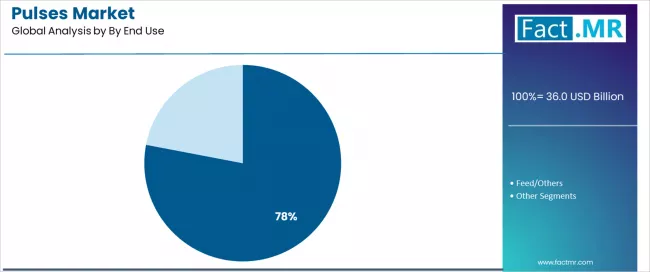
| Segment | 2025 to 2035 Outlook |
|---|---|
| Food | Dominant segment with 78.0% market share, encompassing direct human consumption, food processing applications, and ingredient utilization across diverse food categories. Established consumption patterns with nutritional and cultural significance. Momentum: steady growth driven by protein demand and plant-based food expansion. Watchouts: taste preferences, cooking convenience requirements. |
| Feed/Others | Represents 22.0% market share, focused on animal feed applications and industrial uses requiring lower-grade pulse varieties. Cost-effective protein source for livestock nutrition and specialized industrial applications. Momentum: moderate growth via livestock industry expansion and alternative protein feed development. Innovation-dependent with feed formulation optimization and nutritional efficiency requirements. |
DRIVERS
| DRIVERS | RESTRAINTS | KEY TRENDS |
|---|---|---|
| Global Protein Demand Growth | Weather Dependency Challenges | Processing Technology Innovation |
| Continuing expansion of protein consciousness across established and emerging markets driving demand for plant-based protein solutions. | Weather patterns and climate variability affecting pulse production consistency and supply chain predictability for manufacturers. | Integration of advanced milling technologies, protein extraction systems, and functional enhancement enabling superior ingredient quality. |
| Sustainability Recognition | Cultural Preference Limitations | Plant-Based Food Integration |
| Increasing recognition of pulses' environmental benefits and eco-friendly agriculture importance driving demand across food applications. | Cultural dietary preferences and cooking tradition limitations affecting pulse adoption in certain regional markets and consumer segments. | Enhanced food product development, flavor optimization, and convenience preparation methods compared to traditional pulse consumption. |
| Premium Nutrition Positioning | Processing Cost Complexity | Functional Ingredient Development |
| Growing demand for ingredients that support both nutritional enhancement and environmental sustainability in food manufacturing applications. | Complex processing requirements for value-added pulse products affecting production costs and technological investment needs. | Development of pulse-based protein concentrates, functional flours, and specialized ingredients providing enhanced nutritional and functional benefits. |
Analysis of Pulses Market by Key Countries
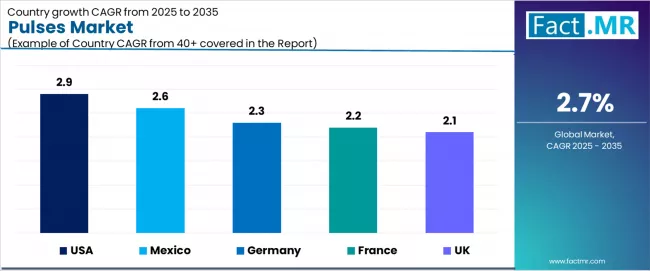
| Country | CAGR (2025-2035) |
|---|---|
| USA | 2.9% |
| Germany | 2.3% |
| France | 2.2% |
| Mexico | 2.6% |
| UK | 2.1% |
USA Leads Global Market Growth with Agricultural Innovation Excellence
The USA is projected to exhibit strong growth with a market value of USD 12.5 billion by 2035, driven by expanding plant-based food industry infrastructure and comprehensive eco-friendly agriculture programs creating substantial opportunities for pulse suppliers across food manufacturing operations, agricultural production, and protein ingredient sectors. The country's established pulse farming regions and expanding plant-based protein capabilities are creating significant demand for both conventional and organic pulse varieties. Major agricultural companies and food manufacturers including pulse processors, plant-based food producers, and agricultural cooperatives are establishing comprehensive supply chains to support large-scale processing operations and meet growing demand for sustainable protein solutions.
- Plant-based food industry modernization programs are supporting widespread adoption of pulse ingredient systems across manufacturing operations, driving demand for high-quality protein ingredients
- Sustainable agriculture initiatives and protein diversification programs are creating substantial opportunities for pulse suppliers requiring proven sustainability credentials and nutritional performance solutions
- Food processing innovation and ingredient development programs are facilitating adoption of specialized pulse technologies throughout major agricultural and food manufacturing regions
Germany Demonstrates Strong Market Potential with Sustainable Food Innovation Growth
Germany is expanding to reach USD 6.8 billion by 2035, supported by extensive organic food industry modernization and comprehensive eco-friendly ingredient development creating steady demand for reliable pulse solutions across diverse food manufacturing categories and organic food segments. The country's advanced sustainable agriculture position and expanding plant-based food capabilities are driving demand for pulse solutions that provide consistent nutritional performance while supporting environmental compliance requirements. Agricultural producers and food manufacturers are investing in local pulse processing facilities to support growing manufacturing operations and eco-friendly ingredient demand.
- Eco-friendly agriculture operations expansion and organic food capability development are creating opportunities for pulse solutions across diverse food segments requiring reliable performance and environmental compliance
- Food technology modernization and plant-based ingredient advancement are driving investments in pulse supply chains supporting protein requirements throughout major food manufacturing regions
- Research and development programs for sustainable nutrition are enhancing demand for precision-processed pulse systems throughout German agricultural and food production areas
France Maintains Leadership with Culinary Innovation
France is projected to reach USD 5.9 billion by 2035, supported by the country's leadership in culinary innovation and advanced food systems requiring sophisticated pulse ingredients for traditional cuisine enhancement and modern food applications. French food manufacturers are implementing high-quality pulse ingredient systems that support culinary excellence, nutritional enhancement, and comprehensive quality standards. The market is characterized by focus on culinary tradition, eco-friendly practices, and compliance with stringent food quality and authenticity standards.
- Advanced culinary industry investments are prioritizing proven pulse technologies that demonstrate superior nutritional performance and culinary functionality while meeting French food quality and eco-friendly standards
- Food tradition leadership programs and culinary excellence initiatives are driving adoption of precision-processed pulse systems that support advanced culinary requirements and product differentiation
- Research and development programs for culinary innovation are facilitating adoption of specialized pulse technologies throughout major food production and culinary centers
Mexico Expands Market with Agricultural Development
Mexico is growing to reach USD 4.2 billion by 2035, driven by agricultural development programs and increasing food processing modernization creating constant opportunities for pulse suppliers serving both traditional food markets and emerging protein-focused manufacturers. The country's established pulse cultivation tradition and growing food processing capabilities are creating demand for pulse solutions that support diverse culinary needs while maintaining cultural food preferences. Agricultural producers and food distributors are developing market strategies to support accessibility and nutritional quality.
- Agricultural development programs and food processing modernization are facilitating adoption of pulse solutions capable of supporting diverse cultural requirements and accessible pricing standards
- Traditional food enhancement and nutrition improvement programs are enhancing demand for pulse varieties that support culinary authenticity and nutritional improvement
- Food industry development initiatives and agricultural adoption programs are creating opportunities for advanced pulse cultivation and processing capabilities across Mexican agricultural regions
UK Focuses on Eco-friendly Protein Solutions
The UK is projected to reach USD 3.7 billion by 2035, expanding at a CAGR of 2.1%, driven by sustainable protein excellence and specialized nutrition capabilities supporting comprehensive food sustainability and plant-based food development. The country's established sustainable agriculture tradition and growing plant-based market segments are creating demand for high-quality pulse solutions that support nutritional performance and eco-friendly standards. Agricultural producers and food manufacturers are maintaining comprehensive development capabilities to support diverse eco-friendly food requirements.
- Sustainable protein programs and specialized nutrition systems are supporting demand for high-performance pulses that meet contemporary sustainability and nutritional standards
- Food innovation and plant-based development programs are creating opportunities for specialized pulse solutions that provide comprehensive protein support
- Agricultural innovation and sustainability enhancement programs are facilitating adoption of advanced pulse cultivation capabilities throughout major agricultural regions
Europe Market Split by Country
The pulses market in Europe is projected to grow from USD 11.2 billion in 2025 to USD 13.8 billion by 2035, registering a CAGR of 2.1% over the forecast period. Germany is expected to maintain its leadership position with a 28.6% market share in 2025, supported by its advanced sustainable agriculture sector and plant-based food capabilities including major pulse processing facilities and organic farming operations.
France follows with a 24.1% share in 2025, projected to reach 24.4% by 2035, driven by comprehensive culinary tradition programs and food innovation initiatives. The United Kingdom holds a 16.9% share in 2025, expected to maintain 16.7% by 2035 despite post-Brexit agricultural trade adjustments. Italy commands a 15.2% share, while Spain accounts for 11.6% in 2025. The Rest of Europe region is anticipated to gain momentum, expanding its collective share from 3.6% to 4.2% by 2035, attributed to increasing sustainable agriculture adoption in Nordic countries and emerging Eastern European agricultural markets implementing pulse cultivation programs.
Premium Quality Standards Define Japanese Market Dynamics
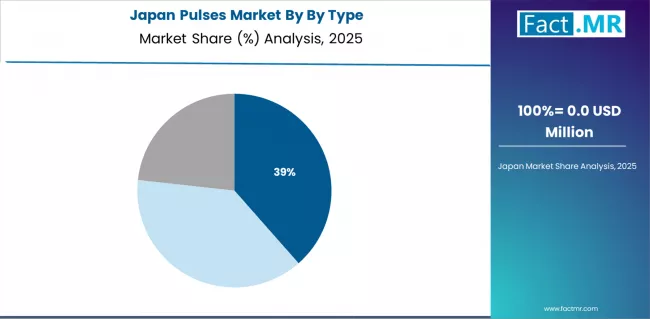
Japanese pulses operations reflect the country's exacting quality standards and sophisticated food requirements. Major food manufacturers and agricultural companies maintain rigorous ingredient qualification processes that often exceed international standards, requiring extensive quality testing, safety validation, and culinary compatibility assessment that can take 12-18 months to complete. This creates high barriers for new suppliers but ensures consistent quality that supports premium food positioning.
The Japanese market demonstrates unique application requirements, with significant demand for ultra-precise pulse specifications tailored to Japanese culinary traditions and food processing requirements. Companies require specific variety characteristics and quality parameters that may differ from Western applications, driving demand for specialized cultivation and processing capabilities.
Regulatory oversight through the Ministry of Agriculture, Forestry and Fisheries emphasizes comprehensive safety management and quality standards that surpass most international requirements. The agricultural product approval system requires detailed cultivation documentation and safety validation, creating advantages for suppliers with robust quality systems and comprehensive regulatory compliance.
Food ingredient management focuses on long-term quality relationships rather than purely transactional procurement patterns. Japanese companies typically maintain agricultural supplier relationships spanning decades, with product specifications emphasizing quality consistency over price considerations. This stability supports investment in specialized pulse cultivation and processing tailored to Japanese food requirements.
Market Dynamics Drive Innovation in South Korea
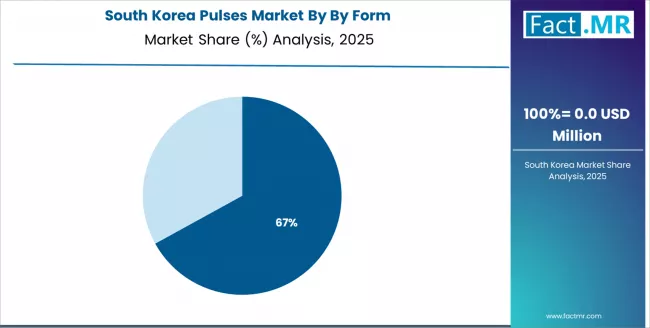
South Korean pulses operations reflect the country's advanced food industry and nutrition-oriented consumer model. Major food companies and agricultural processors drive sophisticated ingredient strategies, establishing direct relationships with global suppliers to secure consistent quality and innovation for their food operations targeting both domestic consumers and food export markets.
The Korean market demonstrates particular strength in applying pulse ingredients to traditional and modern food applications, with companies integrating nutritional enhancement and cultural food concepts into products designed for health-conscious consumers. This application focus creates demand for specific pulse specifications that often exceed standard nutritional requirements, requiring suppliers to adapt cultivation practices and processing features.
Regulatory frameworks emphasize food safety and agricultural innovation, with Korean standards often exceeding international benchmarks for quality and safety. This creates barriers for lower-quality suppliers but benefits established agricultural producers who can demonstrate advanced capabilities. The regulatory environment particularly favors suppliers with proven safety records and comprehensive quality documentation.
Agricultural efficiency remains critical given Korea's focus on food security and eco-friendly agriculture. Companies increasingly pursue long-term contracts with suppliers in North America and other pulse-producing regions to ensure reliable access to high-quality pulses while managing import requirements. Advanced storage investments support quality preservation during international shipping and seasonal supply management.
Competitive Landscape of Pulses Market
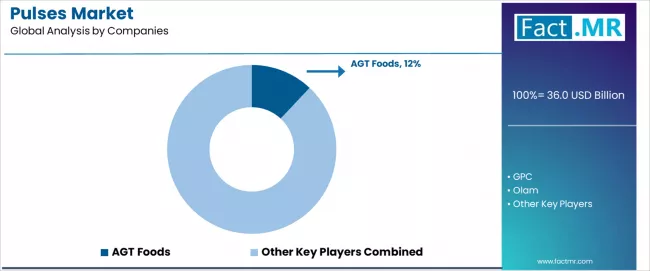
Profit pools are consolidating upstream in scaled agricultural operations and downstream in value-added processing solutions for food manufacturing, ingredient supply, and consumer markets. Value is migrating from basic commodity trading to specification-tight, sustainably-sourced pulses where traceability, nutritional consistency, and processing functionality command premiums. Several archetypes set the pace: global agricultural traders defending share through supply chain scale and geographic diversification; specialized pulse processors that focus on food ingredient applications; sustainable agriculture leaders with organic certification IP and environmental positioning; and plant-based protein innovators pulling value through functional ingredient development and nutritional enhancement.
Switching costs, supplier qualification, supply contracts, processing optimization, stabilize pricing for incumbents, while weather volatility (drought, flooding, climate patterns) and sustainability requirements reopen share for diversified agricultural networks. Consolidation and vertical integration continue; direct food manufacturer relationships dominate ingredient supply as retail channels remain brand-dependent. Market dynamics favor suppliers with comprehensive supply chain management, sustainability credentials, and established food industry relationships.
The competitive environment presents both opportunities and constraints. Advanced processing requirements create barriers for basic commodity traders but establish quality standards that favor specialized pulse companies over generic agricultural suppliers. Market consolidation accelerates as companies seek economies of scale to absorb weather risk and sustainability compliance expenses.
| Stakeholder Type | Primary Advantage | Repeatable Plays |
|---|---|---|
| Global agricultural traders | Scale, geographic diversification, supply integration | Long-term supply contracts, weather risk management, logistics optimization |
| Specialized pulse processors | Processing focus, food industry expertise | Ingredient specifications, quality consistency, application development |
| Sustainable agriculture leaders | Organic certification IP and environmental positioning | Sustainability credentials, traceability systems, premium positioning |
| Plant-based protein innovators | Functional ingredient development and nutritional enhancement | Protein extraction, functional properties, nutritional optimization |
Key Players in the Pulses Market
- AGT Foods
- GPC
- Olam
- Ebro Foods
- Archer Daniels Midland
- Viterra
- Buhler
- Bunge
- Louis Dreyfus
- ETG (Archer lines)
Scope of the Report
| Items | Values |
|---|---|
| Quantitative Units | USD 36.0 billion |
| Product | Lentils, Chickpeas, Dry peas/beans |
| Form | Whole pulses, Processed flour/Protein isolates |
| Regions Covered | North America, Latin America, Europe, Asia Pacific, Middle East & Africa |
| Country Covered | United States, Germany, France, Mexico, UK, and other 40+ countries |
| Key Companies Profiled | AGT Foods, GPC, Olam, Ebro Foods, Archer Daniels Midland, Viterra, Buhler, Bunge, Louis Dreyfus, ETG |
| Additional Attributes | Dollar sales by type/form/end use, regional demand (NA, EU, APAC), competitive landscape, sustainable agriculture adoption, plant-based protein development, and processing innovation technologies driving nutritional enhancement, sustainability optimization, and functional improvement |
Pulses Market Segmentation
-
By Type :
- Lentils
- Chickpeas
- Dry peas/beans
-
By Form :
- Whole pulses
- Processed flour/Protein isolates
-
By End Use :
- Food
- Feed/Others
-
By Region :
- North America
- Europe
- Asia Pacific
- Latin America
- Middle East & Africa
Table of Content
- Executive Summary
- Global Market Outlook
- Demand to side Trends
- Supply to side Trends
- Technology Roadmap Analysis
- Analysis and Recommendations
- Market Overview
- Market Coverage / Taxonomy
- Market Definition / Scope / Limitations
- Market Background
- Market Dynamics
- Drivers
- Restraints
- Opportunity
- Trends
- Scenario Forecast
- Demand in Optimistic Scenario
- Demand in Likely Scenario
- Demand in Conservative Scenario
- Opportunity Map Analysis
- Product Life Cycle Analysis
- Supply Chain Analysis
- Investment Feasibility Matrix
- Value Chain Analysis
- PESTLE and Porter’s Analysis
- Regulatory Landscape
- Regional Parent Market Outlook
- Production and Consumption Statistics
- Import and Export Statistics
- Market Dynamics
- Global Market Analysis 2020 to 2024 and Forecast, 2025 to 2035
- Historical Market Size Value (USD Million) Analysis, 2020 to 2024
- Current and Future Market Size Value (USD Million) Projections, 2025 to 2035
- Y to o to Y Growth Trend Analysis
- Absolute $ Opportunity Analysis
- Global Market Pricing Analysis 2020 to 2024 and Forecast 2025 to 2035
- Global Market Analysis 2020 to 2024 and Forecast 2025 to 2035, By Type
- Introduction / Key Findings
- Historical Market Size Value (USD Million) Analysis By Type , 2020 to 2024
- Current and Future Market Size Value (USD Million) Analysis and Forecast By Type , 2025 to 2035
- Dry peas/beans
- Lentils
- Chickpeas
- Y to o to Y Growth Trend Analysis By Type , 2020 to 2024
- Absolute $ Opportunity Analysis By Type , 2025 to 2035
- Global Market Analysis 2020 to 2024 and Forecast 2025 to 2035, By Form
- Introduction / Key Findings
- Historical Market Size Value (USD Million) Analysis By Form, 2020 to 2024
- Current and Future Market Size Value (USD Million) Analysis and Forecast By Form, 2025 to 2035
- Whole pulses
- Processed flour/Protein isolates
- Y to o to Y Growth Trend Analysis By Form, 2020 to 2024
- Absolute $ Opportunity Analysis By Form, 2025 to 2035
- Global Market Analysis 2020 to 2024 and Forecast 2025 to 2035, By End Use
- Introduction / Key Findings
- Historical Market Size Value (USD Million) Analysis By End Use, 2020 to 2024
- Current and Future Market Size Value (USD Million) Analysis and Forecast By End Use, 2025 to 2035
- Food
- Feed/Others
- Y to o to Y Growth Trend Analysis By End Use, 2020 to 2024
- Absolute $ Opportunity Analysis By End Use, 2025 to 2035
- Global Market Analysis 2020 to 2024 and Forecast 2025 to 2035, By Region
- Introduction
- Historical Market Size Value (USD Million) Analysis By Region, 2020 to 2024
- Current Market Size Value (USD Million) Analysis and Forecast By Region, 2025 to 2035
- North America
- Latin America
- Western Europe
- Eastern Europe
- East Asia
- South Asia and Pacific
- Middle East & Africa
- Market Attractiveness Analysis By Region
- North America Market Analysis 2020 to 2024 and Forecast 2025 to 2035, By Country
- Historical Market Size Value (USD Million) Trend Analysis By Market Taxonomy, 2020 to 2024
- Market Size Value (USD Million) Forecast By Market Taxonomy, 2025 to 2035
- By Country
- USA
- Canada
- Mexico
- By Type
- By Form
- By End Use
- By Country
- Market Attractiveness Analysis
- By Country
- By Type
- By Form
- By End Use
- Key Takeaways
- Latin America Market Analysis 2020 to 2024 and Forecast 2025 to 2035, By Country
- Historical Market Size Value (USD Million) Trend Analysis By Market Taxonomy, 2020 to 2024
- Market Size Value (USD Million) Forecast By Market Taxonomy, 2025 to 2035
- By Country
- Brazil
- Chile
- Rest of Latin America
- By Type
- By Form
- By End Use
- By Country
- Market Attractiveness Analysis
- By Country
- By Type
- By Form
- By End Use
- Key Takeaways
- Western Europe Market Analysis 2020 to 2024 and Forecast 2025 to 2035, By Country
- Historical Market Size Value (USD Million) Trend Analysis By Market Taxonomy, 2020 to 2024
- Market Size Value (USD Million) Forecast By Market Taxonomy, 2025 to 2035
- By Country
- Germany
- UK
- Italy
- Spain
- France
- Nordic
- BENELUX
- Rest of Western Europe
- By Type
- By Form
- By End Use
- By Country
- Market Attractiveness Analysis
- By Country
- By Type
- By Form
- By End Use
- Key Takeaways
- Eastern Europe Market Analysis 2020 to 2024 and Forecast 2025 to 2035, By Country
- Historical Market Size Value (USD Million) Trend Analysis By Market Taxonomy, 2020 to 2024
- Market Size Value (USD Million) Forecast By Market Taxonomy, 2025 to 2035
- By Country
- Russia
- Poland
- Hungary
- Balkan & Baltic
- Rest of Eastern Europe
- By Type
- By Form
- By End Use
- By Country
- Market Attractiveness Analysis
- By Country
- By Type
- By Form
- By End Use
- Key Takeaways
- East Asia Market Analysis 2020 to 2024 and Forecast 2025 to 2035, By Country
- Historical Market Size Value (USD Million) Trend Analysis By Market Taxonomy, 2020 to 2024
- Market Size Value (USD Million) Forecast By Market Taxonomy, 2025 to 2035
- By Country
- China
- Japan
- South Korea
- By Type
- By Form
- By End Use
- By Country
- Market Attractiveness Analysis
- By Country
- By Type
- By Form
- By End Use
- Key Takeaways
- South Asia and Pacific Market Analysis 2020 to 2024 and Forecast 2025 to 2035, By Country
- Historical Market Size Value (USD Million) Trend Analysis By Market Taxonomy, 2020 to 2024
- Market Size Value (USD Million) Forecast By Market Taxonomy, 2025 to 2035
- By Country
- India
- ASEAN
- Australia & New Zealand
- Rest of South Asia and Pacific
- By Type
- By Form
- By End Use
- By Country
- Market Attractiveness Analysis
- By Country
- By Type
- By Form
- By End Use
- Key Takeaways
- Middle East & Africa Market Analysis 2020 to 2024 and Forecast 2025 to 2035, By Country
- Historical Market Size Value (USD Million) Trend Analysis By Market Taxonomy, 2020 to 2024
- Market Size Value (USD Million) Forecast By Market Taxonomy, 2025 to 2035
- By Country
- Kingdom of Saudi Arabia
- Other GCC Countries
- Turkiye
- South Africa
- Other African Union
- Rest of Middle East & Africa
- By Type
- By Form
- By End Use
- By Country
- Market Attractiveness Analysis
- By Country
- By Type
- By Form
- By End Use
- Key Takeaways
- Key Countries Market Analysis
- USA
- Pricing Analysis
- Market Share Analysis, 2024
- By Type
- By Form
- By End Use
- Canada
- Pricing Analysis
- Market Share Analysis, 2024
- By Type
- By Form
- By End Use
- Mexico
- Pricing Analysis
- Market Share Analysis, 2024
- By Type
- By Form
- By End Use
- Brazil
- Pricing Analysis
- Market Share Analysis, 2024
- By Type
- By Form
- By End Use
- Chile
- Pricing Analysis
- Market Share Analysis, 2024
- By Type
- By Form
- By End Use
- Germany
- Pricing Analysis
- Market Share Analysis, 2024
- By Type
- By Form
- By End Use
- UK
- Pricing Analysis
- Market Share Analysis, 2024
- By Type
- By Form
- By End Use
- Italy
- Pricing Analysis
- Market Share Analysis, 2024
- By Type
- By Form
- By End Use
- Spain
- Pricing Analysis
- Market Share Analysis, 2024
- By Type
- By Form
- By End Use
- France
- Pricing Analysis
- Market Share Analysis, 2024
- By Type
- By Form
- By End Use
- India
- Pricing Analysis
- Market Share Analysis, 2024
- By Type
- By Form
- By End Use
- ASEAN
- Pricing Analysis
- Market Share Analysis, 2024
- By Type
- By Form
- By End Use
- Australia & New Zealand
- Pricing Analysis
- Market Share Analysis, 2024
- By Type
- By Form
- By End Use
- China
- Pricing Analysis
- Market Share Analysis, 2024
- By Type
- By Form
- By End Use
- Japan
- Pricing Analysis
- Market Share Analysis, 2024
- By Type
- By Form
- By End Use
- South Korea
- Pricing Analysis
- Market Share Analysis, 2024
- By Type
- By Form
- By End Use
- Russia
- Pricing Analysis
- Market Share Analysis, 2024
- By Type
- By Form
- By End Use
- Poland
- Pricing Analysis
- Market Share Analysis, 2024
- By Type
- By Form
- By End Use
- Hungary
- Pricing Analysis
- Market Share Analysis, 2024
- By Type
- By Form
- By End Use
- Kingdom of Saudi Arabia
- Pricing Analysis
- Market Share Analysis, 2024
- By Type
- By Form
- By End Use
- Turkiye
- Pricing Analysis
- Market Share Analysis, 2024
- By Type
- By Form
- By End Use
- South Africa
- Pricing Analysis
- Market Share Analysis, 2024
- By Type
- By Form
- By End Use
- USA
- Market Structure Analysis
- Competition Dashboard
- Competition Benchmarking
- Market Share Analysis of Top Players
- By Regional
- By Type
- By Form
- By End Use
- Competition Analysis
- Competition Deep Dive
- AGT Foods
- Overview
- Product Portfolio
- Profitability by Market Segments (Product/Age /Sales Channel/Region)
- Sales Footprint
- Strategy Overview
- Marketing Strategy
- Product Strategy
- Channel Strategy
- GPC
- Olam
- Ebro Foods
- Archer Daniels Midland
- Viterra
- Buhler
- Bunge
- Louis Dreyfus
- ETG
- AGT Foods
- Competition Deep Dive
- Assumptions & Acronyms Used
- Research Methodology
List Of Table
- Table 1: Global Market Value (USD Million) Forecast by Region, 2020 to 2035
- Table 2: Global Market Value (USD Million) Forecast by Type , 2020 to 2035
- Table 3: Global Market Value (USD Million) Forecast by Form, 2020 to 2035
- Table 4: Global Market Value (USD Million) Forecast by End Use, 2020 to 2035
- Table 5: North America Market Value (USD Million) Forecast by Country, 2020 to 2035
- Table 6: North America Market Value (USD Million) Forecast by Type , 2020 to 2035
- Table 7: North America Market Value (USD Million) Forecast by Form, 2020 to 2035
- Table 8: North America Market Value (USD Million) Forecast by End Use, 2020 to 2035
- Table 9: Latin America Market Value (USD Million) Forecast by Country, 2020 to 2035
- Table 10: Latin America Market Value (USD Million) Forecast by Type , 2020 to 2035
- Table 11: Latin America Market Value (USD Million) Forecast by Form, 2020 to 2035
- Table 12: Latin America Market Value (USD Million) Forecast by End Use, 2020 to 2035
- Table 13: Western Europe Market Value (USD Million) Forecast by Country, 2020 to 2035
- Table 14: Western Europe Market Value (USD Million) Forecast by Type , 2020 to 2035
- Table 15: Western Europe Market Value (USD Million) Forecast by Form, 2020 to 2035
- Table 16: Western Europe Market Value (USD Million) Forecast by End Use, 2020 to 2035
- Table 17: Eastern Europe Market Value (USD Million) Forecast by Country, 2020 to 2035
- Table 18: Eastern Europe Market Value (USD Million) Forecast by Type , 2020 to 2035
- Table 19: Eastern Europe Market Value (USD Million) Forecast by Form, 2020 to 2035
- Table 20: Eastern Europe Market Value (USD Million) Forecast by End Use, 2020 to 2035
- Table 21: East Asia Market Value (USD Million) Forecast by Country, 2020 to 2035
- Table 22: East Asia Market Value (USD Million) Forecast by Type , 2020 to 2035
- Table 23: East Asia Market Value (USD Million) Forecast by Form, 2020 to 2035
- Table 24: East Asia Market Value (USD Million) Forecast by End Use, 2020 to 2035
- Table 25: South Asia and Pacific Market Value (USD Million) Forecast by Country, 2020 to 2035
- Table 26: South Asia and Pacific Market Value (USD Million) Forecast by Type , 2020 to 2035
- Table 27: South Asia and Pacific Market Value (USD Million) Forecast by Form, 2020 to 2035
- Table 28: South Asia and Pacific Market Value (USD Million) Forecast by End Use, 2020 to 2035
- Table 29: Middle East & Africa Market Value (USD Million) Forecast by Country, 2020 to 2035
- Table 30: Middle East & Africa Market Value (USD Million) Forecast by Type , 2020 to 2035
- Table 31: Middle East & Africa Market Value (USD Million) Forecast by Form, 2020 to 2035
- Table 32: Middle East & Africa Market Value (USD Million) Forecast by End Use, 2020 to 2035
List Of Figures
- Figure 1: Global Market Pricing Analysis
- Figure 2: Global Market Value (USD Million) Forecast 2020-2035
- Figure 3: Global Market Value Share and BPS Analysis by Type , 2025 and 2035
- Figure 4: Global Market Y to o to Y Growth Comparison by Type , 2025-2035
- Figure 5: Global Market Attractiveness Analysis by Type
- Figure 6: Global Market Value Share and BPS Analysis by Form, 2025 and 2035
- Figure 7: Global Market Y to o to Y Growth Comparison by Form, 2025-2035
- Figure 8: Global Market Attractiveness Analysis by Form
- Figure 9: Global Market Value Share and BPS Analysis by End Use, 2025 and 2035
- Figure 10: Global Market Y to o to Y Growth Comparison by End Use, 2025-2035
- Figure 11: Global Market Attractiveness Analysis by End Use
- Figure 12: Global Market Value (USD Million) Share and BPS Analysis by Region, 2025 and 2035
- Figure 13: Global Market Y to o to Y Growth Comparison by Region, 2025-2035
- Figure 14: Global Market Attractiveness Analysis by Region
- Figure 15: North America Market Incremental Dollar Opportunity, 2025-2035
- Figure 16: Latin America Market Incremental Dollar Opportunity, 2025-2035
- Figure 17: Western Europe Market Incremental Dollar Opportunity, 2025-2035
- Figure 18: Eastern Europe Market Incremental Dollar Opportunity, 2025-2035
- Figure 19: East Asia Market Incremental Dollar Opportunity, 2025-2035
- Figure 20: South Asia and Pacific Market Incremental Dollar Opportunity, 2025-2035
- Figure 21: Middle East & Africa Market Incremental Dollar Opportunity, 2025-2035
- Figure 22: North America Market Value Share and BPS Analysis by Country, 2025 and 2035
- Figure 23: North America Market Value Share and BPS Analysis by Type , 2025 and 2035
- Figure 24: North America Market Y to o to Y Growth Comparison by Type , 2025-2035
- Figure 25: North America Market Attractiveness Analysis by Type
- Figure 26: North America Market Value Share and BPS Analysis by Form, 2025 and 2035
- Figure 27: North America Market Y to o to Y Growth Comparison by Form, 2025-2035
- Figure 28: North America Market Attractiveness Analysis by Form
- Figure 29: North America Market Value Share and BPS Analysis by End Use, 2025 and 2035
- Figure 30: North America Market Y to o to Y Growth Comparison by End Use, 2025-2035
- Figure 31: North America Market Attractiveness Analysis by End Use
- Figure 32: Latin America Market Value Share and BPS Analysis by Country, 2025 and 2035
- Figure 33: Latin America Market Value Share and BPS Analysis by Type , 2025 and 2035
- Figure 34: Latin America Market Y to o to Y Growth Comparison by Type , 2025-2035
- Figure 35: Latin America Market Attractiveness Analysis by Type
- Figure 36: Latin America Market Value Share and BPS Analysis by Form, 2025 and 2035
- Figure 37: Latin America Market Y to o to Y Growth Comparison by Form, 2025-2035
- Figure 38: Latin America Market Attractiveness Analysis by Form
- Figure 39: Latin America Market Value Share and BPS Analysis by End Use, 2025 and 2035
- Figure 40: Latin America Market Y to o to Y Growth Comparison by End Use, 2025-2035
- Figure 41: Latin America Market Attractiveness Analysis by End Use
- Figure 42: Western Europe Market Value Share and BPS Analysis by Country, 2025 and 2035
- Figure 43: Western Europe Market Value Share and BPS Analysis by Type , 2025 and 2035
- Figure 44: Western Europe Market Y to o to Y Growth Comparison by Type , 2025-2035
- Figure 45: Western Europe Market Attractiveness Analysis by Type
- Figure 46: Western Europe Market Value Share and BPS Analysis by Form, 2025 and 2035
- Figure 47: Western Europe Market Y to o to Y Growth Comparison by Form, 2025-2035
- Figure 48: Western Europe Market Attractiveness Analysis by Form
- Figure 49: Western Europe Market Value Share and BPS Analysis by End Use, 2025 and 2035
- Figure 50: Western Europe Market Y to o to Y Growth Comparison by End Use, 2025-2035
- Figure 51: Western Europe Market Attractiveness Analysis by End Use
- Figure 52: Eastern Europe Market Value Share and BPS Analysis by Country, 2025 and 2035
- Figure 53: Eastern Europe Market Value Share and BPS Analysis by Type , 2025 and 2035
- Figure 54: Eastern Europe Market Y to o to Y Growth Comparison by Type , 2025-2035
- Figure 55: Eastern Europe Market Attractiveness Analysis by Type
- Figure 56: Eastern Europe Market Value Share and BPS Analysis by Form, 2025 and 2035
- Figure 57: Eastern Europe Market Y to o to Y Growth Comparison by Form, 2025-2035
- Figure 58: Eastern Europe Market Attractiveness Analysis by Form
- Figure 59: Eastern Europe Market Value Share and BPS Analysis by End Use, 2025 and 2035
- Figure 60: Eastern Europe Market Y to o to Y Growth Comparison by End Use, 2025-2035
- Figure 61: Eastern Europe Market Attractiveness Analysis by End Use
- Figure 62: East Asia Market Value Share and BPS Analysis by Country, 2025 and 2035
- Figure 63: East Asia Market Value Share and BPS Analysis by Type , 2025 and 2035
- Figure 64: East Asia Market Y to o to Y Growth Comparison by Type , 2025-2035
- Figure 65: East Asia Market Attractiveness Analysis by Type
- Figure 66: East Asia Market Value Share and BPS Analysis by Form, 2025 and 2035
- Figure 67: East Asia Market Y to o to Y Growth Comparison by Form, 2025-2035
- Figure 68: East Asia Market Attractiveness Analysis by Form
- Figure 69: East Asia Market Value Share and BPS Analysis by End Use, 2025 and 2035
- Figure 70: East Asia Market Y to o to Y Growth Comparison by End Use, 2025-2035
- Figure 71: East Asia Market Attractiveness Analysis by End Use
- Figure 72: South Asia and Pacific Market Value Share and BPS Analysis by Country, 2025 and 2035
- Figure 73: South Asia and Pacific Market Value Share and BPS Analysis by Type , 2025 and 2035
- Figure 74: South Asia and Pacific Market Y to o to Y Growth Comparison by Type , 2025-2035
- Figure 75: South Asia and Pacific Market Attractiveness Analysis by Type
- Figure 76: South Asia and Pacific Market Value Share and BPS Analysis by Form, 2025 and 2035
- Figure 77: South Asia and Pacific Market Y to o to Y Growth Comparison by Form, 2025-2035
- Figure 78: South Asia and Pacific Market Attractiveness Analysis by Form
- Figure 79: South Asia and Pacific Market Value Share and BPS Analysis by End Use, 2025 and 2035
- Figure 80: South Asia and Pacific Market Y to o to Y Growth Comparison by End Use, 2025-2035
- Figure 81: South Asia and Pacific Market Attractiveness Analysis by End Use
- Figure 82: Middle East & Africa Market Value Share and BPS Analysis by Country, 2025 and 2035
- Figure 83: Middle East & Africa Market Value Share and BPS Analysis by Type , 2025 and 2035
- Figure 84: Middle East & Africa Market Y to o to Y Growth Comparison by Type , 2025-2035
- Figure 85: Middle East & Africa Market Attractiveness Analysis by Type
- Figure 86: Middle East & Africa Market Value Share and BPS Analysis by Form, 2025 and 2035
- Figure 87: Middle East & Africa Market Y to o to Y Growth Comparison by Form, 2025-2035
- Figure 88: Middle East & Africa Market Attractiveness Analysis by Form
- Figure 89: Middle East & Africa Market Value Share and BPS Analysis by End Use, 2025 and 2035
- Figure 90: Middle East & Africa Market Y to o to Y Growth Comparison by End Use, 2025-2035
- Figure 91: Middle East & Africa Market Attractiveness Analysis by End Use
- Figure 92: Global Market - Tier Structure Analysis
- Figure 93: Global Market - Company Share Analysis
- FAQs -
How big is the pulses market in 2025?
The global pulses market is estimated to be valued at USD 36.0 billion in 2025.
What will be the size of pulses market in 2035?
The market size for the pulses market is projected to reach USD 46.8 billion by 2035.
How much will be the pulses market growth between 2025 and 2035?
The pulses market is expected to grow at a 2.7% CAGR between 2025 and 2035.
What are the key product types in the pulses market?
The key product types in pulses market are dry peas/beans, lentils and chickpeas.
Which by form segment to contribute significant share in the pulses market in 2025?
In terms of by form, whole pulses segment to command 64.0% share in the pulses market in 2025.